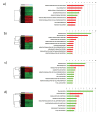15 kDa Granulysin versus GM-CSF for monocytes differentiation: analogies and differences at the transcriptome level
- PMID: 21501511
- PMCID: PMC3094223
- DOI: 10.1186/1479-5876-9-41
15 kDa Granulysin versus GM-CSF for monocytes differentiation: analogies and differences at the transcriptome level
Abstract
Background: Granulysin is an antimicrobial and proinflammatory protein with several isoforms. While the 9 kDa isoform is a well described cytolytic molecule with pro-inflammatory activity, the functions of the 15 kDa isoform is less well understood. Recently it was shown that 15 kDa Granulysin can act as an alarmin that is able to activate monocytes and immature dendritic cells. Granulocyte Macrophage Colony Stimulating Factor (GM-CSF) is a growth factor widely used in immunotherapy both for in vivo and ex vivo applications, especially for its proliferative effects.
Methods: We analyzed gene expression profiles of monocytes cultured with 15 kDa Granulysin or GM-CSF for 4, 12, 24 and 48 hours to unravel both similarities and differences between the effects of these stimulators.
Results: The analysis revealed a common signature induced by both factors at each time point, but over time, a more specific signature for each factor became evident. At all time points, 15 kDa Granulysin induced immune response, chemotaxis and cell adhesion genes. In addition, only 15 kDa Granulsyin induced the activation of pathways related to fundamental dendritic cell functions, such as co-stimulation of T-cell activation and Th1 development. GM-CSF specifically down-regulated genes related to cell cycle arrest and the immune response. More specifically, cytokine production, lymphocyte mediated immunity and humoral immune response were down-regulated at late time points.
Conclusion: This study provides important insights on the effects of a novel agent, 15 kDa granulysin, that holds promise for therapeutic applications aimed at the activation of the immune response.
Figures





Similar articles
-
Activities of granulocyte-macrophage colony-stimulating factor and interleukin-3 on monocytes.Am J Hematol. 2004 Apr;75(4):179-89. doi: 10.1002/ajh.20010. Am J Hematol. 2004. PMID: 15054806
-
Role of the cytokine environment and cytokine receptor expression on the generation of functionally distinct dendritic cells from human monocytes.Eur J Immunol. 2008 Mar;38(3):750-62. doi: 10.1002/eji.200737395. Eur J Immunol. 2008. PMID: 18236400
-
Feasibility to generate monocyte-derived dendritic cell from coculture with melanoma tumor cells in the presence of granulocyte/macrophage colony-stimulating factor (GM-CSF) and interleukin-4.Am J Reprod Immunol. 2003 Apr;49(4):230-8. doi: 10.1034/j.1600-0897.2003.01200.x. Am J Reprod Immunol. 2003. PMID: 12852497
-
Regulation of dendritic cell development by GM-CSF: molecular control and implications for immune homeostasis and therapy.Blood. 2012 Apr 12;119(15):3383-93. doi: 10.1182/blood-2011-11-370130. Epub 2012 Feb 8. Blood. 2012. PMID: 22323450 Review.
-
Biology and clinical relevance of granulysin.Tissue Antigens. 2009 Mar;73(3):193-8. doi: 10.1111/j.1399-0039.2008.01218.x. Tissue Antigens. 2009. PMID: 19254247 Free PMC article. Review.
Cited by
-
Upregulated serum granulysin levels in women with antiphospholipid antibody-associated recurrent miscarriage are downregulated by heparin treatment.Reprod Med Biol. 2022 Apr 17;21(1):e12460. doi: 10.1002/rmb2.12460. eCollection 2022 Jan-Dec. Reprod Med Biol. 2022. PMID: 35444491 Free PMC article.
-
The study of novel DNA vaccines against tuberculosis: induction of pathogen-specific CTL in the mouse and monkey models of tuberculosis.Hum Vaccin Immunother. 2013 Mar;9(3):515-25. doi: 10.4161/hv.23229. Epub 2012 Dec 18. Hum Vaccin Immunother. 2013. PMID: 23249543 Free PMC article.
-
Dendritic cells: an immunotherapy coming of age.Immunotherapy. 2012 Oct;4(10):973-4. doi: 10.2217/imt.12.102. Immunotherapy. 2012. PMID: 23148746 Free PMC article. No abstract available.
-
15 kDa granulysin causes differentiation of monocytes to dendritic cells but lacks cytotoxic activity.J Immunol. 2012 Jun 15;188(12):6119-26. doi: 10.4049/jimmunol.1200570. Epub 2012 May 14. J Immunol. 2012. PMID: 22586033 Free PMC article.
-
Cell death mechanisms at the maternal-fetal interface: insights into the role of granulysin.Clin Dev Immunol. 2012;2012:180272. doi: 10.1155/2012/180272. Epub 2011 Sep 8. Clin Dev Immunol. 2012. PMID: 21912564 Free PMC article. Review.
References
Publication types
MeSH terms
Substances
LinkOut - more resources
Full Text Sources

